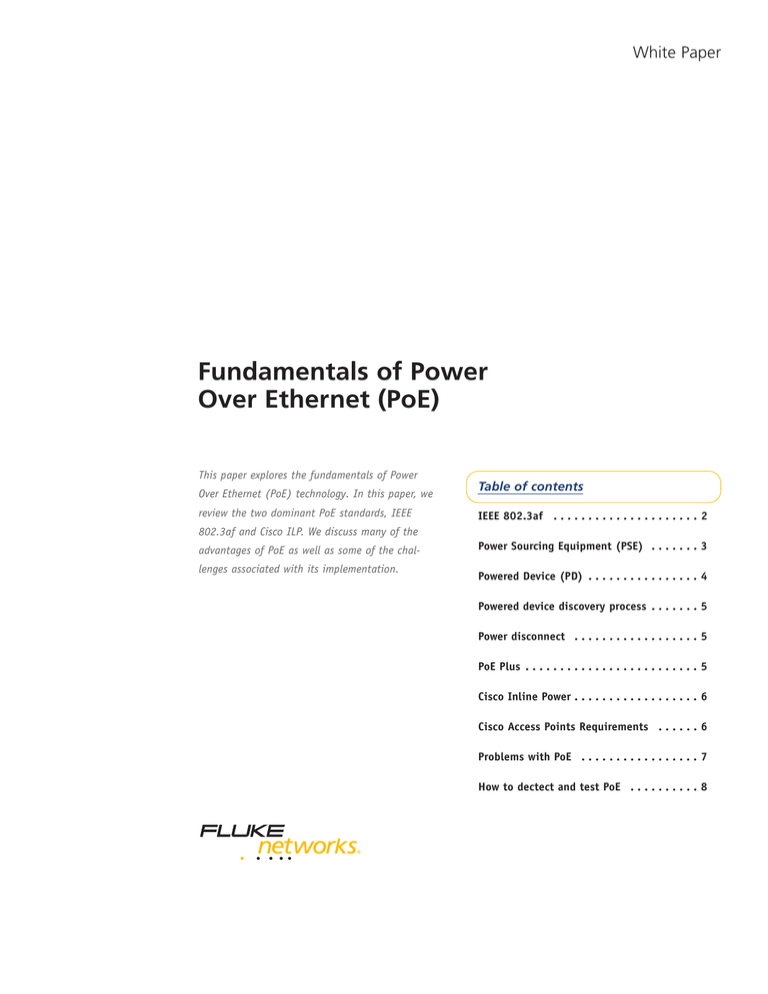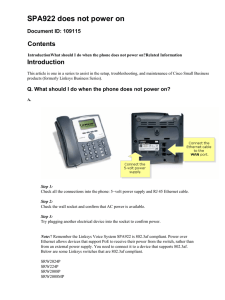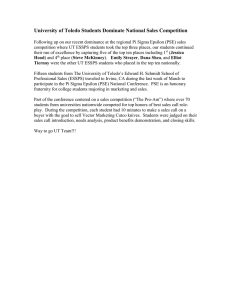
White Paper
Fundamentals of Power
Over Ethernet (PoE)
This paper explores the fundamentals of Power
Over Ethernet (PoE) technology. In this paper, we
review the two dominant PoE standards, IEEE
Table of contents
IEEE 802.3af . . . . . . . . . . . . . . . . . . . . . 2
802.3af and Cisco ILP. We discuss many of the
advantages of PoE as well as some of the challenges associated with its implementation.
Power Sourcing Equipment (PSE) . . . . . . . 3
Powered Device (PD) . . . . . . . . . . . . . . . . 4
Powered device discovery process . . . . . . . 5
Power disconnect . . . . . . . . . . . . . . . . . . 5
PoE Plus . . . . . . . . . . . . . . . . . . . . . . . . . 5
Cisco Inline Power . . . . . . . . . . . . . . . . . . 6
Cisco Access Points Requirements . . . . . . 6
Problems with PoE . . . . . . . . . . . . . . . . . 7
How to dectect and test PoE . . . . . . . . . . 8
White Paper
Fundamentals of Power Over Ethernet (PoE)
Executive summary
Local power is not always accessible for wireless access points, IP phones, and other network devices that may be deployed in ceilings, lobbies, stairwells, and other obscure areas. Adding power outlets near these devices may be extremely difficult, and costly.
Why not give these devices network connection and power in the same cable? This question is resolved by PoE technology. PoE is a
technology designed to deliver power to networking devices using existing data communcations cabling.
In June 2003, the IEEE 802.3af Power over Ethernet committee approved the Data Terminal Equipment (DTE) Power via Media
Dependent Interface amendment to the existing 802.3 standard. This defined how power would be delivered to devices also utilizing
10BASE-T, 100BASE-T, and 1000BASE-T technologies.
Previous to this standard, companies such as Cisco Systems developed vendor-proprietary technology to deliver power to Ethernet
devices. The Cisco “flavor” of PoE is called Cisco Inline Power (Cisco ILP), launched in March 2000. Since then, Cisco ILP has been
installed in a large number of networks. This situation has called for Cisco to provide standards-based PoE that is backward compatible
with existing installations of Cisco ILP.
Benefits of PoE include:
• Power and data on one cable
• No need for external power
• More control over the edge device
• Device can be moved easily
• Simpler deployment of devices
• Power management and monitoring via SNMP
• No need to upgrade existing cabling systems (UTP Cat 5 or better)
This white paper will explore how the standards-based 802.3af PoE operates, including how networks detect a connected PoE supported device, the differences in the existing installation of Cisco Inline Power from 802.3af, and problems associated with PoE.
IEEE 802.3af
The IEEE 802.3af standard defines delivery of up to 15.4 watts per port to Ethernet devices, typically using 48 volts. The standard
specifies around 350 mA per connection, so at 48V, this results in 16W to a device. Mostly, these are access points and IP phones, but
there are other devices such as handheld PCs, printers, magnetic card readers, and web cameras that are being developed to utilize
802.3af. There is room in the specification to expand to other devices that currently do not draw power from PoE, such as laptops and
desktop PCs. These devices, however, are not currently supported by the technology.
802.3af defines two major pieces of hardware, the Powered Device or PD (the actual device receiving the power) and the Power
Sourcing Equipment or PSE (the device providing power to the PD). All devices that utilize PoE fit into one of these two definitions.
An IP phone is an example of a PD, and a PoE capable switch can be a PSE. The standard also defines the process of detecting PD,
and how power is maintained and discontinued to this device.
Fluke Networks
2
www.flukenetworks.com
White Paper
Power Sourcing Equipment (PSE)
The PSE has three main functions:
• Detect a PoE capable PD
• Supply power to the PD
• Monitor and terminate the supplied power
Within the definition of a PSE, there are two types described: endpoint PSE and midspan PSE. An endpoint PSE is a Power over
Ethernet capable port on a switch that is directly connected to the cable supplying power to the PD. Power is delivered by the endpoint PSE using either the active data pairs (usually the orange and green pairs in Ethernet – Pins 1,2 and 3,6) or the spare pairs
(usually the brown and blue pairs – 4,5 and 7,8). These two delivery methods are referred to as alternative A and B. Alternative A
uses the active data pairs; and alternative B uses the spare pairs.
Switch PSE
Access Point
RX
1, 2
+ 48 V
TX
1, 2
TX
3, 6
- 48 V
RX
3, 6
4, 5
4, 5
7, 8
7, 8
Alternative A, power over data pairs
Switch PSE
Access Point
RX
1, 2
TX
1, 2
TX
3, 6
RX
3, 6
4, 5
7, 8
+ 48 V
- 48 V
4, 5
7, 8
Alternative B, power over spare pairs
Fluke Networks
3
www.flukenetworks.com
White Paper
In order to be 802.3af compliant, the PSE must support both alternative A and B. However, only one method will be used to provide
power to a device. Typically, this will be the A method for the standard 802.3af PSE.
A mid-point PSE provides power to a PD when no powered Ethernet port is available. It is commonly known as a power injector or
power hub that connects physically inline between an Ethernet data port and the PD. It is either a single connection plug, or a multiconnection injector that feeds many connections.
Switch
Switch
PD
PD
PSE
PD
PSE
Multi-connection hub
Single connection
According to the standard, these mid-span devices only support providing power over the spare pairs of the cable (alternative B), and
do not support 1000BASE-T connections.
Powered Device (PD)
An 802.3af compliant powered device is able to accept power using either the alternative A or B method. PDs that do not support
receiving power on either the data or spare pairs are not compliant, nor are devices that require power on all four pairs. Therefore,
some vendor-specific PoE technologies may not work with a switch that is providing 802.3af power to the PD. This is not a mandatory
option on either the part of the PD or the PSE, however, both must support this feature in order to properly utilize it.
An option exists in the standard for a PD to inform the PSE of its power needs. PDs can be qualified into classes according to their
power needs. Some PDs need little wattage to operate, while some may need the full 15.4 watts provided by the PSE. The class assignments are as follows:
• Class 0 needs .44 to 12.95 watts
• Class 1 needs .44 to 3.84 watts
• Class 2 needs 3.84 to 6.49 watts
• Class 3 needs 6.49 to 12.95 watts
*Note – This requirement at the PD is less than what is measured at the PSE. The measured power is slightly higher. For example, on a
PD in the class 0 range, the PSE will provide up to 15.4W to the PD.
Class 0 is the default state for a PSE when providing power to the PD. Unless this optional classification is supported, the PSE will
assume the device is class 0, and provide 15.4W to the PD.
The PSE learns the class of the connected PD by transmitting voltage to the PD on the power positive pair, and measuring the attenuation of the voltage on the power negative pair. The level of the returned signal will classify the PD.
Fluke Networks
4
www.flukenetworks.com
White Paper
A PD that advertises its class has certain advantages over a device that operates only in the 15.4W mode. For one thing, if a device
can run at a wattage that is lower than the default setting, the switch can save power to that device, allocating it to another port.
For example, if three phones are connected that only require 6.3W, the switch can save 9.1W per port. This is a total wattage savings
of 27.3W. If this is multiplied across the entire switch, the result is less draw for the switch itself, saving in overall power costs. The
switch also may not need as extensive a cooling system, as the lower wattage output will not generate as much heat.
PD discovery process
An obvious requirement of the 802.3af standard is to prevent damage to existing
Device is
connected to
a PSE and 2.7
V - 10 V is
applied to 1, 2
and 3, 6
Ethernet equipment that does not require PoE. In an operational mode, a PSE
should not apply power to a connection until it can verify that a PD is attached
and requesting power. This occurs before the Ethernet link is activated on the
connection – obviously, because the PD isn’t powered yet!
A discovery process run from the PSE examines the connection, probing for
Device applies
load at 25 K
Ohms
NO
Device is not a
valid PD, wait
backoff time
devices that support PoE. This process is performed by applying a small currentlimited DC voltage to the device between the transmit and receive pairs, while
measuring the load applied by the device. Valid PDs will have a 25k Ohm resistor
YES
bridged across the transmit and receive pairs. Power will only be applied to the
connection if this load is detected by the PSE. Devices that do not have this
resistance between pairs will not have the proper signature to trigger the PSE to
802.3 af Compliant
device is attached.
48 V at 350 mA is
applied to 1, 2
and 3, 6
apply power. Once the device is detected as a valid PD, the optional classification
signal may be sent.
The PSE will send discovery signals on active and inactive Ethernet ports to
Discovery process 802.3af
detect connected PDs, with a backoff time of a minimum 2 seconds between
signals. These discovery signals will continue until power is needed to a PD, when the signal will turn into actual power. Even when a
nonpowered device is connected, the signals will continue. The detection process must occur in less than 500ms.
Power disconnect
It may happen that a user swaps a connection from a powered to a nonpowered device. When the connection is established to the
nonpowered device, the 48V power source could damage it. The 802.3af standard specifies the PSE to disconnect power to a device
when it stops receiving a power signature from the PD. When the connection is terminated, power will be cut around 250ms later.
PoE Plus
In November 2004, a study group was formed to create Power over Ethernet Plus. This group is researching the future of the PoE
technology, with a goal of powering devices that need more than twice the wattage applied by 802.3af, such as a laptop. Goals of PoE
Plus are:
• A PoE Plus PSE will be compatible with legacy 802.3af, being able to power both 802.3af and PoE Plus PDs
• PoE Plus should provide at least 30W to powered devices
• Develop midspan specifications for 1000BASE-T
• Develop midspan and endspan specifications for 10GBASE-T
Fluke Networks
5
www.flukenetworks.com
White Paper
PoE is an evolving techology that will experience rapid growth over the next few years. Tools to test and monitor PoE will be necessary as switch vendors continue to implement it into their products. While the technology is still in its early stages, cross-vendor
compatibility problems may occur, making PoE difficult to troubleshoot without tools.
Cisco Inline Power
Cisco Inline Power (ILP) is a Cisco-proprietary technology used to power Cisco APs and phones. It was defined in March of 2000 and
has an install base of more than 16 million ports. Cisco ILP is no longer used in new devices, although most Cisco PDs do support
either Cisco ILP or 802.3af.
There are a few ways that Cisco ILP and 802.3af differ in their operation. Mostly these affect only the detection sequences and power
management. For the most part, there is little difference in the two technologies once power is applied.
In the PD detection sequence, Cisco ILP uses AC powered device detection to probe for valid powered devices. It transmits a low
frequency AC signal to the PD and expects the same signal to be measured on the receive pair. The signal will go through a low-pass
filter between the transmit and receive pairs. This filter allows the signal to pass through, but prevents 10/100/1000Mbps frames from
being bridged between the pairs. If this is the case, the PD detection signal is good. As described previously, 802.3af uses a DC voltage measurement to determine if a PD is present.
Cisco ILP will continuously transmit this detection signal on a connection whether linkstate is active or not. When a powered device is
detected and power is applied, as long as the link is active, the power will continue to be transmitted. As soon as the link fails,
power is cut to the PD.
Using the CDP protocol, a Cisco ILP PD has the ability to inform the PSE of its power needs. There is no need for the 802.3af classification sequence in Cisco ILP. At first, the PD will come up in low-power mode and begin transmitting a CDP packet to the PSE,
informing it of its power needs. If the device requires less than 15.4 watts, the PSE will modify the power applied to the PD and
adjust it accordingly. This provides management capablity of the available power budget at the PSE. If a device does not need additional power, it will not get it.
This power management capability also allows a powered device to intelligently power up in a low-power mode if the PSE is not able
to meet a higher power demand. For example, when an access point first boots up, it can draw 7W, instead of the full 15.4W. After the
AP is powered, it can move to high-power once the switch has negotiated that it can support the higher power draw. If the switch
port cannot support the higher draw, the AP can operate in low-power mode, with a bit of reduced functionality. The AP may only
operate one antenna instead of two, to conserve power.
Cisco Access Point requirements
• AP1100
4.9W
• APW/802.11a
8W
• AP1200/802.11b
6W
• AP1200/802.11 a/b
11W
• AP340/350
<5W
Fluke Networks
6
www.flukenetworks.com
White Paper
Problems with PoE
Overall, PoE is a very resilient technology. If both the PSE and the PD are speaking the same language (802.3af or Cisco ILP), then
problems powering devices should be unlikely. The biggest consideration when using PoE is the overall power draw to the switch itself.
Here’s a scenario:
In a particular office floor, there may be 220 phones and 15 access points, all requiring Power over Ethernet. Using the standard
power, with no Cisco intelligent power management, each device will be allocated 15.4W. This results in a total of 3619W to power all
devices. The PSE itself is most likely a large switch that requires somewhere in the area of 1500W itself. This results in a total power
requirement of almost 4200W to this one switch!
It cannot be assumed that most wiring closets can handle this kind of load to the electrical system. The typical 110V/15Amp circuit
can only supply around 1600W. A larger 220V/20Amp circuit may need to be installed. Additionally, the cooling system may need to
be upgraded in order to keep the switch from overheating. Before installing a large number of PoE devices, take the facilities into
account and make sure that overall power consumption and cooling are considered.
Summary
Power over Ethernet is now installed everywhere. With the surge in VoIP and wireless implementations, PoE is increasingly being used
to provide power to these devices. Before power is applied to a device, it is tested by the switch to see if it is a device that can be
powered by 802.3af. After this detection, 48V at around 350mA is applied to the device, powering it up and allowing linkstate to be
achieved. If the switch itself is supplying the power, most likely, it will be on the data pairs (1,2 and 3,6). An inline power injector
may also be used if the switch is not capable of providing power and data to the device. Power will then be applied to the device on
the spare pairs (4,5 and 7,8). The device will accept this power until the switch no longer detects that the device is attached, and
then power will be terminated.
IEEE 802.3af and Cisco Inline Power both have built-in functions that allow for only the proper amount of power to be applied to a
device. In the case of 802.3af, the power source classifies the device and scales back power. Cisco Inline Power requires the end
device to come up in low-power mode and request more if it is needed. In the latest implementations of 802.3af compliant devices,
Cisco has allowed for backward-compatability to its pre-standard powering specification. Mostly this allows new IP phones to be
powered by older switches.
Overall power consumption and cooling are very important factors to consider when deploying PoE. At a 15.4W default setting, total
power can add up very quickly. Backup UPS power may also need to be upgraded to support the total draw to the switch.
Power over Ethernet is a technology that will redefine the way that VoIP and wireless networks are built. Undoubtedly, it will be
everywhere within the next two years.
Fluke Networks
7
www.flukenetworks.com
White Paper
How to detect and test PoE with Fluke Networks’ NetTool™ Inline Network Tester
When connected inline between a PSE and a PD, NetTool Inline Tester has the capability of measuring power applied to
a connection.
IEEE 802.3af
An IEEE 802.3af standards-compliant PoE switch will send a detection signal to a connected device. This signal will be
detected by the NetTool and passed through to the device connected to the other RJ-45 connection.
When the NetTool is first connected between a PSE and PD, it will attempt to establish a link on both sides. The PSE will
detect this link signature and will begin sending PoE detection signals. At this point the NetTool
will detect these signals and will stop sending link signals. After a few seconds, the NetTool will
pass the PoE detection signals to the PD, enabling it to power up and establish link.
Once power has been passed through to the PD, NetTool will link to both sides of the connection. Power applied to the PD
can be measured by the NetTool on either side. Select the UP arrow on the keypad to highlight the NetTool itself. The screen
on the NetTool icon will begin blinking. Select the left or right button on the keypad to select either the PSE or the PD then
use the Select button to view the Link Configuration for that device.
The device measured above had a PoE voltage of 50.4V over pairs 1,2 3,6. Speed, duplex, and RX pair
are also displayed here.
Some implementations of Power over Ethernet are not engineered according to the 802.3af standard,
especially those built before June 2003. There is a chance that they will not use this PD detection process, and may enable
voltage according to another detection scheme. For these pre-standard PoE implementations, NetTool will have varied results.
Midspan Power Injector and Cisco Inline Power
NetTool behavior on Midspan Power Injector or Cisco Inline Power systems is not significantly different than on 802.3af.
For injected power, the NetTool will pass power directly through to the PD. In most cases, power will be measured on the
non-data pairs, 4,5 and 7,8. Other than this, there is little difference in the way NetTool treats the different versions of
Power Over Ethernet.
Note: The NetTool tester must be version 2 hardware in order to pass PoE signals from one side to the other. An easy way to
tell if a NetTool is version 2 hardware is by the color of the plastic case. If it is blue, the NetTool is version 2. If it is grey,
the hardware is version 1, and the tool will not pass PoE.
N E T W O R K S U P E R V I S I O N
Fluke Networks
P.O. Box 777, Everett, WA USA 98206-0777
Fluke Networks operates in more than 50 countries
worldwide. To find your local office contact details, go
to www.flukenetworks.com/contact.
©2005 Fluke Corporation. All rights reserved.
Printed in U.S.A. 6/2005 2496921 A-US-N Rev A
Fluke Networks
8
www.flukenetworks.com





